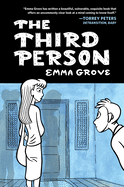
Debut author Emma Grove's luminous graphic memoir opens with a declaration: "None of the following incidents are made up or invented... I wish they were." Grove presents The Third Person in stark black-and-white panels with drawings outlined in a thick black line. The simplicity of her art is a stark contrast to the harrowing hardships she survived while seeking gender-affirming healthcare.
Grove is transgender. By age 33, living as a man is utterly untenable. To commence medical transition requires the approval of a gender therapist. Grove settles with Toby (who's also trans) because he doesn't make demands about interrogating her past--at least not initially. Their meetings dominate the narrative as Grove reveals her "parts," that she is actually three "separate" people: overworked, exhausted Ed; aggressively protective Katina; and tentative, thoughtful Emma. Toby, self-admittedly, is not equipped to treat her, yet she continues to return. Her eventual Dissociative Identity Disorder diagnosis becomes a wrenching challenge to identify, accept and resolve. Healing demands she must finally confront the geneses of her ongoing dissociations. Her dancing with abandon at book's end, depicted in color, is a worthy celebration indeed.
Despite the memoir's hefty page count, Grove's accomplished storytelling will undoubtedly encourage single-sitting reads. Those hundreds of pages of therapy sessions, beyond a guilt-tinged voyeuristic awe, might not seem scintillating by description. But Grove manifests her superb artistry in capturing emotions and reactions with a mere tip of the head, an angled face, animated eyebrows and added hand gestures. Grove's "gigantic jigsaw puzzle" proves to be a gift to behold. --Terry Hong, Smithsonian BookDragon

